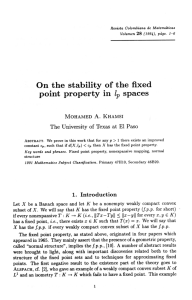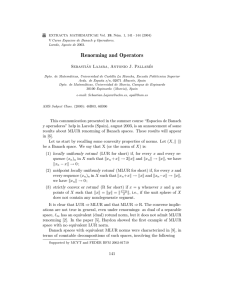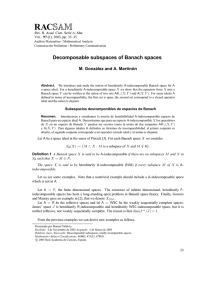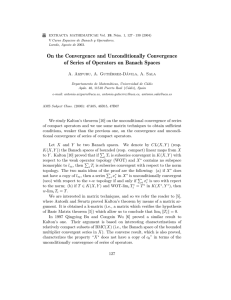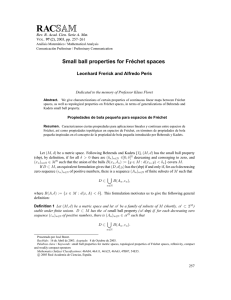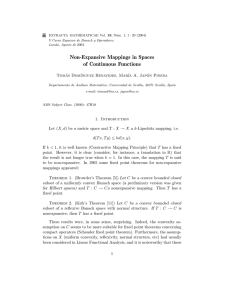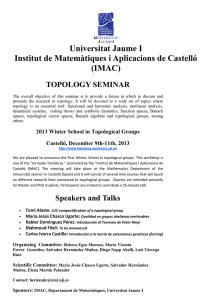Geometric Properties of Banach Spaces and Metric Fixed Point Theory
Anuncio
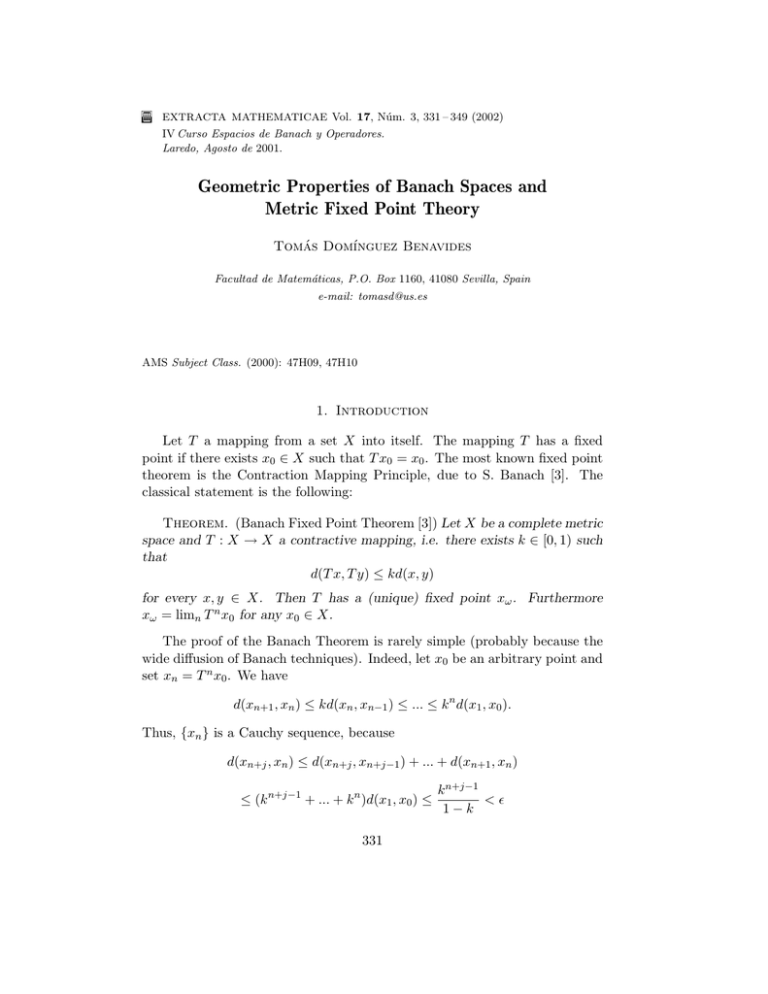
E
extracta mathematicae Vol. 17, Núm. 3, 331 – 349 (2002)
IV Curso Espacios de Banach y Operadores.
Laredo, Agosto de 2001.
Geometric Properties of Banach Spaces and
Metric Fixed Point Theory
Tomás Domı́nguez Benavides
Facultad de Matemáticas, P.O. Box 1160, 41080 Sevilla, Spain
e-mail: tomasd@us.es
AMS Subject Class. (2000): 47H09, 47H10
1. Introduction
Let T a mapping from a set X into itself. The mapping T has a fixed
point if there exists x0 ∈ X such that T x0 = x0 . The most known fixed point
theorem is the Contraction Mapping Principle, due to S. Banach [3]. The
classical statement is the following:
Theorem. (Banach Fixed Point Theorem [3]) Let X be a complete metric
space and T : X → X a contractive mapping, i.e. there exists k ∈ [0, 1) such
that
d(T x, T y) ≤ kd(x, y)
for every x, y ∈ X. Then T has a (unique) fixed point xω . Furthermore
xω = limn T n x0 for any x0 ∈ X.
The proof of the Banach Theorem is rarely simple (probably because the
wide diffusion of Banach techniques). Indeed, let x0 be an arbitrary point and
set xn = T n x0 . We have
d(xn+1 , xn ) ≤ kd(xn , xn−1 ) ≤ ... ≤ k n d(x1 , x0 ).
Thus, {xn } is a Cauchy sequence, because
d(xn+j , xn ) ≤ d(xn+j , xn+j−1 ) + ... + d(xn+1 , xn )
≤ (k n+j−1 + ... + k n )d(x1 , x0 ) ≤
331
k n+j−1
<²
1−k
332
t. domı́nguez
if n is large enough. Obviously, the fixed point is unique, because if x = T x,
y = T y we have d(x, y) = d(T x, T y) ≤ kd(x, y) which implies d(x, y) = 0.
Banach Theorem has proved to be very useful to solve different theoretical
and practical problems. For instance, it is used to prove the Picard-Lindelöf
Theorem about existence of solution of differential equations and to prove
the Inverse (or Implicit) Function Theorem in infinite dimensional spaces.
A big number of generalizations of the Banach Theorem have appeared in
the literature, trying to weak some assumptions (see, for instance, [11, Cap.
3]). However, the most natural improvement would be to let the constant
k attain the value 1, but in this case the result is not more true. Indeed, a
translation in R satisfies the assumptions and it is fixed point free. Even the
mild assumption d(T x, T y) < d(x, y) does not assure the existence of a fixed
point. Indeed, consider X = [1, ∞) and T x = x + 1/x. We have
¯
¯
¯
¯
¯
¯1 1¯
1
1¯
d(T x, T y) = ¯¯x + − y − ¯¯ = |y − x| − ¯¯ − ¯¯ < |y − x|.
x
y
x y
However T is fixed point free. The fail of the existence of fixed point in this
example occurs because, in addition, the interval [1, ∞) is unbounded. Indeed,
otherwise we could apply Brouwer’s Theorem:
Theorem. (Brouwer’s Theorem (1912) [5]) Let M a bounded convex
closed subset of Rn and T : M → M a continuous mapping. Then T has
a fixed point.
Having in mind both Banach and Brouwer Theorems, a question seems
to be natural: Assume that M is a convex, closed bounded subset of an
arbitrary Banach space and T : M → M is a nonexpansive mapping, i.e.,
kT x − T yk ≤ kx − yk for every x, y ∈ M . Does T has a fixed point? We must
realize that the assumption on the space has been weakened (the dimension
is not necessarily finite) but stronger conditions are assumed on the mapping
(nonexpansiveness instead of continuity). The answer in again negative:
Example. (Kakutani (1943) [9]). Let B the unit ball in c0 and T : B → B
defined by T (x1 , x2 , ...) = (1 − kxk, x1 , x2 , ...). It is easy to check that T is
nonexpansive and fixed point free.
As a consequence of these facts, the problems about existence of fixed point
for nonexpansive mappings were relegated. However in 1965, two surprising
theorems appeared:
geometric properties of banach spaces
333
Theorem. (Browder’s Theorem [6]) Let C be a convex bounded closed
subset of a uniformly convex Banach space (a preliminary version was given
for Hilbert spaces) and T : C → C a nonexpansive mapping. Then T has a
fixed point.
Theorem. (Kirk’s Theorem [10]) Let C be a convex bounded closed
subset of a reflexive Banach space with normal structure. If T : C → C
is nonexpansive, then T has a fixed point.
In the second section we will include a proof of the latter theorem (which
includes Browder’s Theorem). It is noteworthy that these results state a bridge
between notions which had usually been considered in Linear Functional
Analysis (uniform convexity, reflexivity, normal structure, etc) and problems
about existence of fixed point for nonlinear operators. From this starting point
a big number of fixed point results have been obtained for different classes
of mappings using geometric properties of Banach spaces. In forthcoming
sections we will review some of these results.
2. Normal structure. Existence of fixed points for
nonexpansive operators
We recall some definitions yielding to the notion of normal structure.
Definition 1. Let X be a Banach space, A a bounded subset of X and
B an arbitrary subset of X. The Chebyshev radius of A with respect to B is
defined by
r(A, B) = inf{sup{kx − yk : x ∈ A} : y ∈ B}
where we write r(A) instead of r(A, co (A)). The Chebyshev center of A with
respect to B is defined by
Z(A, B) = {y ∈ B : sup{kx − yk : x ∈ A} = r(A, B)}
where we write Z(A) instead of Z(A, co (A)).
Remark 1. Roughly speaking, we can say that the Chebyshev radius
r(A, B) is the radius of the smallest ball centered at a point in B and covering
the set A, the Chebyshev center Z(A, B) being the set formed by all centers of
these smallest balls. However, since the infimum appearing in the definition
334
t. domı́nguez
is not, necessarily attained, the set Z(A, B) can be empty. In opposition, if
for every ε > 0 we consider the set
Zε (A, B) = {y ∈ B : r(A, y) ≤ r(A, B) + ε},
then Zε (A, B) is a nonempty, convex, bounded and closed set if B satisfies the
same properties. Thus, Zε (A, B) is convex, nonempty and weakly compact if
so is B. Since
\
Zε (A, B) = Z(A, B),
ε>0
the finite intersection property implies that Z(A, B) is nonempty when B is
a convex and weakly compact set.
Definition 2. A bounded convex closed subset A of a Banach space X
is said to be diametral if diam (A) = r(A). Equivalently, if Z(A) = A.
We say that a Banach space X has normal structure (respectively weak
normal structure) if every convex closed nonempty (respectively convex weakly
compact ) diametral subset of X is a singleton.
Remark 2. According to the above definition, a Banach space has normal
structure if every convex set A which is not a singleton can be covered by a
ball whose radius is less than the diameter of A and centered at a point in A.
We could think that this is the case of every Banach space, and in fact, this
occurs for every uniformly convex space (we will see the definition in the next
section), for instance, `p and Lp (Ω), 1 < p < +∞. However the sequence space
c0 fails to have both normal structure and weak normal structure. Indeed,
consider the set A = co ({en : n ∈ N}) where{en } is the standard basis. We
have diam (A) = 1 and r(A) = 1 because limn→∞ kx − en k = 1 for every
x ∈ c0 . Furthermore, since the sequence {en } is weakly null, A is a weakly
compact set. The same set can be considered in the sequence space `1 , giving
us that `1 fails to have normal structure either. However, we will show in
the next section that `1 (and any Banach space with the Schur property) has
weak normal structure.
Theorem 1. Let X be a Banach space with weak normal structure, C a
convex weakly compact subset of X and T : C → C a nonexpansive mapping.
Then T has a fixed point.
Proof. Let B be the collection of all convex weakly compact subsets of
C which are T -invariant. It is easy to check that B, ordered by inclusion is
geometric properties of banach spaces
335
an inductive family. Zorn’s Lemma assures the existence of a minimal set
K. Since T (K) ⊂ K we have co (T (K)) ⊂ K. Thus, co (T (K)) is a convex
weakly compact subset of K which is T − invariant.The minimality of K
implies K = co (T (K)). Since K is a weakly compact convex set, we know
from Remark 1 that Z(K) is a nonempty convex weakly compact set. We will
prove that Z(K) is T -invariant. Indeed, take x ∈ Z(K), i.e. r(K, x) = r(K).
For every y ∈ K we have kT y −T xk ≤ ky −xk ≤ r(K). Hence T (K) is covered
by the closed ball B(T x, r(K)) which implies co (T (K)) = K ⊂ B(T x, r(K)).
Therefore r(K, T x) ≤ r(K) which implies T x ∈ Z(K). The minimality of
K implies Z(K) = K and thus diam (K) = 0 because X has weak normal
structure. Hence K is a singleton and contains a fixed point of T .
3. Geometric properties which imply normal structure
In order to study some geometric properties implying normal structure we
recall a geometric coefficient defined by Bynum [7] in 1980 (a preliminary form
had been studied by por Jüng in 1901).
Definition 3. Let X be a Banach space. The normal structure coefficient
of X is defined by
n
diam (A) : A ⊂ X convex closed and
r(A)
o
bounded with diam (A) > 0 .
N (X) = inf
It is clear that X has normal structure if N (X) > 1. However spaces
with normal structure exist which satisfy N (X) = 1. This coefficient can
be considered as a measure of the “worst” possible relationship between the
diameter and the Chebyshev radius of a subset of X. For instance, in the
euclidean plane `22 this “worst”
relationship is attained at the equilateral
√
space `32 it is
triangle and its value is 3. In the tridimensional
√ euclidean
√
attained at the tetrahedron with a value equal to 2 2/ 3 and, in general, for
`n2 √
thepworst value corresponds to the “hipertetrahedron” with a value equal
to 2 (n + 1)/n. It is not easy to evaluate N (X) for a determined space X,
and, in fact, its value is unknown in many cases. The following connection
between the value of N (X) and the reflexivity of the space is important:
Theorem 2. ([12]) Let X be a Banach space such that N (X) > 1. Then
X is reflexive.
336
t. domı́nguez
Proof. If X is not reflexive, for every ε > 0 there exists a sequence {xn }
(see [13]) such that 1−ε ≤ ku1,n −un,ω k ≤ 1+ε for every u1,n ∈ co ({xj }1≤j≤n ),
un,ω ∈ co ({xj }j>n ), and for each n. Thus diam ({xn }) ≤ 1 + ε. Furthermore,
if v belongs to co ({xn }) and n is large enough we have kxn − vk ≥ 1 − ε/2.
Since ε is arbitrary, we obtain N (X) = 1.
The normal structure coefficient is useful to study the stability of the
normal structure under renorming. Recall that if X and Y are isomorphic
Banach spaces, the Banach-Mazur distance between X and Y is defined by
©
ª
d(X, Y ) = inf kT kkT −1 k : T ∈ Isom (X, Y ) .
Clearly, d(X, Y ) = 1 when X and Y are isometric spaces.
Theorem 3. Let X and Y be isomorphic Banach spaces. Then
N (X) ≤ d(X, Y )N (Y ).
Proof. Let C be a bounded convex closed subset of Y . If U : Y → X is
an isomorphism we have
r(C) ≤ kU −1 kr(U (C)) ≤ kU −1 k diam(U (C))/N (X)
≤ kU −1 kkU k diam(C)/N (X).
Thus r(C) ≤ d(X, Y ) diam(C)/N (X) and this inequality implies the result.
The first geometric property, related to normal structure, which will be
considered is the uniform convexity. Let us recall that a Banach space is said to
be strictly convex if the unit sphere does not contain a segment. Equivalently:
Definition 4. We say that a Banach space X is strictly convex if for
every vectors x and y in X which are not collinear, we have
kx + yk < kxk + kyk.
A stronger notion appears if we assume this property in a uniform
sense, that is, roughly speaking, assuming that there is no segment with a
predetermined length as close to the unit sphere as wanted.
geometric properties of banach spaces
337
Definition 5. We say that a Banach space X is uniformly convex, if for
every ε ∈ (0, 2] there exists δ > 0 such that for x, y ∈ X with
)
°
°
°x + y °
kx − yk ≥ ε
°
° > δ.
⇒1−°
2 °
x, y ∈ B(0, 1)
Example 1. Hilbert spaces are uniformly convex as a consequence of the
parallelogram identity. Indeed, if x, y ∈ B(0, 1) and kx − yk ≥ ε, we have
°
° r
³ ´2
°x + y °
°
°≤ 1− ε .
° 2 °
2
q
Considering δ = 1 − (ε/2)2 we obtain the uniform convexity of the space. To
prove that `p spaces are uniformly convex is more technical (see, for instance,
[4]). On the other hand, recall that a Banach space X is finitely representable
in another Banach space Y if for every finite dimensional subspace E of X
and every ε > 0 there exists a subspace F of Y such that d(E, F ) < 1 + ε. It
is not difficult to prove that Lp (Ω) is finitely representable in `p . Indeed, if
E is an n-dimensional subspace of Lp (Ω) and {f1 , f2 , ..., fn } is a normalized
basis of E, with basic constant c, for every ε > 0 we can find simple
functions
k − sk k < ε/nc(2 + ε) for k = 1, ..., n.
Pn{s1 , s2 , ..., sn } such that kfP
If f = k=1 ak fk , we define T f = nk=1 ak sk . Then T is an isomorphism
from E onto span{s1 , ..., sn } and kT kkT −1 k < 1 + ε. Since span{s1 , ..., sn }
can be isometrically embedded in `p (by discretization of the measure), there
exists a subspace F of `p such that d(E, F ) < 1 + ε. Since the definition of
the uniform convexity only depends on 2-dimensional subspaces and Lp ([0, 1])
contains isometrically to `p , we can assure that Lp ([0, 1]) spaces are uniformly
convex for the same choice of δ as in `p .
We will need a measure of the uniform convexity of the space:
Definition 6. Let X be a Banach space. The modulus of convexity of
X, δX (ε), is defined by
°
°
½
¾
°x + y °
° : x, y ∈ B(0, 1), kx − yk ≥ ε .
δX (ε) = inf 1 − °
° 2 °
Theorem 4. Let X be a Banach space with modulus of convexity δX .
Then N (X) ≥ (1 − δX (1))−1 .
338
t. domı́nguez
Proof. Let A be a closed convex bounded subset of X which is not a
singleton and choose ε > 0. Denote d = diam (A) and r = r(A). Choose x
and y in A such that kx − yk ≥ d − ε. Write w = (x + y)/2, and choose z in
A such that kz − wk ≥ r − ε. Since k(z − x)/dk ≤ 1 , k(z − y)/dk ≤ 1 and
k(z − x)/d − (z − y)/dk > (d − ε)/d from the definition of δX we obtain
µ
µ
¶¶
d−ε
kz − wk ≤ d 1 − δX
.
d
Thus
µ
µ
¶¶
d−ε
r ≤ ε + d 1 − δX
d
which implies the result using the continuity of the norm.
Remark 3. Notice that uniform convexity implies normal structure, but
this property is also shared by every space such that segments with length
equal to 1 are separated from the unit sphere. On the other hand, it is well
known that uniformly convex spaces are reflexive. From theorems 2 and 4 a
stronger result is obtained: the condition δX (1) > 0 implies reflexivity.
Next we will review another coefficient which implies weak normal
structure. We will use the notion of asymptotically equilateral sequence
Definition 7. Let X be a metric space. A sequence {xn } in X is said to
be asymptotically equilateral if limn,m ; n6=m d(xn , xm ) exists, i.e., a number d
exists such that for every ε > 0 there is a nonnegative integer n0 such that
d − ε < d(xn , xm ) < d + ε if n, m > n0 and n 6= m.
To study the existence of asymptotically equilateral sequence we will use
a simple version of Ramsey Lemma. Let us fix the notation: By N we denote
the set of nonnegative integers, [N] the collection of its infinite subsets and for
every set C in [N], [C]2 will denote the set formed by all ordered pair formed
with numbers in C.
Lemma. (Ramsey Lemma) Let f : [N]2 → {1, 2} be a function. Then,
there exists C ∈ [N] such that the restriction of f to [C]2 is a constant.
Theorem 5. Let {xn } be a bounded sequence in a metric space. Then
{xn } contains an asymptotically equilateral subsequence.
geometric properties of banach spaces
339
Proof. For every subsequence {yn } of {xn } we denote φ({yn }) = inf{ε >
0 : {yn } can be covered by finitely many sets with diameter ≤ ε}.
Claim.“There exists a subsequence {yn } of {xn } such that φ({zn }) = φ({yn })
for every subsequence {zn } of {yn }.” To prove the claim, define by induction
{zn0 } = {xn } and
φm+1 = inf{φ({zn }) : {zn } subsequence of {znm }}.
Let {znm+1 } be a subsequence of {znm } such that
φ({znm+1 ) < φm+1 +
1
.
m+1
Consider the diagonal subsequence {znn }. We will show that this sequence
satisfies the required condition. Since {znn } is a subsequence of {znm } for n > m
we have φ({znn }) ≤ φ({znm }) for each m. Assume that {zn } is a subsequence
of {znn }. Hence {zn } is a subsequence of {znm } for n > m. Thus
φ({znn }) ≤ φ({znm }) < φm +
1
1
≤ φ({zn }) + .
m
m
Since m is arbitrary we obtain
φ({znn }) ≤ φ({zn }) ≤ φ({znn })
and the claim is proved. Choose now an arbitrary ε > 0 and a subsequence
{yn } of {xn } satisfying the property in the claim. Taking a subsequence (which
“a fortiori” satisfies the same property) we can assume φ({yn })+ε ≥ kyn −ym k
for every n, m. Define the following function from [N]2 into {1, 2}: f (n, m) = 1
if kyn − ym k > φ({yn }) − ε and f (n, m) = 2 if kyn − ym k ≤ φ({yn }) − ε. By
Ramsey’s Lemma, there exists a subsequence {zn } of {yn } satisfying either
kzn − zm k > φ({yn }) − ε for every n, m ; n 6= m or kzn − zm k ≤ φ({yn }) − ε
for every n, m. Since the second possibility is a contradiction according to the
property satisfied by {yn }, we deduce that the first possibility always holds
and we have
φ({yn }) − ε ≤ kzn − zm k < φ({yn }) + ε
for every n, m ; n 6= m. Choosing ε = 1/n we can conclude the proof by a
diagonal argument.
To introduce a coefficient for weak normal structure we need some previous
definitions.
340
t. domı́nguez
Definition 8. The asymptotic diameter, radius and center of a sequence
{xn } in a Banach space X are defined by:
diam a ({xn }) = lim sup{kxn − xm k : n, m ≥ k},
k→∞
ra ({xn }, B) = inf{lim sup kxn − yk : y ∈ B},
n→∞
Za ({xn }, B) = {y ∈ B : lim sup kxn − yk = ra ({xn }, B)},
n→∞
where B is an arbitrary subset of X. Whenever B = co ({xn }) we
will write ra ({xn }) and Za ({xn }) (resp.)
for ra ({xn }, co ({xn })) and
Za ({xn }, co ({xn })).
Definition 9. Let X a Banach space without the Schur property, i.e.,
weakly convergent sequences exist which are not norm converging. The weakly
convergent sequence coefficient of X is defined by
n
a ({xn })
W CS(X) = inf diam
: {xn } is a weakly convergent sequence
ra ({xn })
o
which is not norm converging .
Since the maximum value for W CS(X) in Definition 9 is 2, we can say
that W CS(X) = 2 if X satisfies the Schur property.
Theorem 6. Let X be a Banach space with W CS(X) > 1. Then X has
weak normal structure.
Proof. Assume that X fails to have weak normal structure. Thus, it
contains a weakly compact convex diametral set A with is not a singleton.
Denote d = diam (A) > 0 and let ε < d be an arbitrary positive number.
Choose an arbitrary x1 in A. Recursively we can construct a sequence {xn }
such that
ε
kyn − xn+1 k > d − 2
n
Pn
where yn = i=1 xi /n. Assume
P that x is an arbitrary point
P in the convex
hull of {x1 , ..., xn }, i.e., x = nj=1 αj xj where αj ≥ 0 and nj=1 αj = 1. If
α = max{α1 , ...αn }, we have
n
X
x
yn =
+
nα
j=1
µ
αj
1
−
n nα
¶
xj .
geometric properties of banach spaces
Since
n
X
1
+
nα
µ
j=1
αj
1
−
n nα
¶
=1 ;
341
αj
1
−
≥0
n nα
we have
¶
n µ
X
αj
1
ε
1
d − 2 < kyn − xn+1 k ≤
kx − xn+1 k +
−
kxj − xn+1 k
n
nα
n nα
j=1
¶
µ
1
1
d.
≤
kx − xn+1 k + 1 −
nα
nα
Thus
µ
kx − xn+1 k ≥
d
ε
− 2
nα n
¶
nα = d −
εα
ε
≥d− .
n
n
Hence limn→∞ d(xn+1 , co ({x1 , ..., xn })) = d. Since A is a weakly compact set
and every subsequence of {xn } satisfies the above condition, we can assume
that {xn } is weakly convergent. In particular diam a ({xn }) ≤ d. If X satisfies
the Schur property, {xn } is convergent and we obtain the contradiction d = 0.
Otherwise, if y belongs to the convex hull of {xn } we know that y belongs
to co ({x1 , ..., xk }) for some k. If n > k we have ky − xn k ≥ d − ε/n. Thus
ra ({xn }) ≥ d. Since diam a ({xn }) ≤ d we obtain W CS(X) ≤ 1.
We will show some equivalent useful forms for W CS(X):
Theorem 7. Let X be a Banach space without the Schur property. Then
(a)
n
W CS(X) = inf
diam a ({xn }) : {x } converges weakly to zero
n
lim sup
kxn k
n→∞
o
.
(b)
n
W CS(X) = inf
limn,m ;n6=m kxn −xm k
limn→∞ kxn k
and
lim
n,m ;n6=m
: {xn } converges weakly to zero
o
kxn − xm k and lim kxn k exist .
n→∞
(c)
W CS(X) = inf{
lim
n,m ;n6=m
kxn − xm k : {xn } converges weakly to zero,
kxn k = 1 and
lim
n,m ;n6=m
kxn − xm k exists}.
342
t. domı́nguez
Proof. Let {xn } be a weakly null sequence. For each k ≥ 1,TAk will denote
the closed convex hull of {xn }n≥k . It is easy to check that ∞
k=1 Ak = {0}.
Since the function Φ(x) = lim supn→∞ kxn −xk is lower weakly semicontinuous
and Ak is a weakly compact set, this function attains a minimum on Ak .
Thus the asymptotic Chebyshev center Z({xn }, Ak ) is nonempty. Choose
zk ∈ Z({xn }, Ak ). Since {zk } lies in a weakly compact set and 0 is the
unique cluster point of {zk }, the sequence {zk } converges weakly to 0.
Furthermore {Φ(zk )} is a nondecreasing sequence bounded by Φ(0). Thus
limk→∞ Φ(zk ) ≤ Φ(0). Moreover, the lower weak semicontinuity of Φ implies
limk→∞ Φ(zk ) ≥ Φ(0) and so limk→∞ Φ(zk ) = Φ(0). Since
Φ(zk ) = min lim sup kxn − zk = ra ({xn }n≥k )
z∈Ak
n→∞
we obtain
Φ(zk )W CS(X) ≤ diam a ({xn }).
Taking limits as k goes to infinity we obtain
lim sup kxn kW CS(X) ≤ diam a ({xn })
n→∞
and (a) can be deduced from this inequality. Statements in (b) and (c) can
be obtained from (a) because any bounded sequence has an asymptotically
equilateral subsequence.
Next, we will consider another geometric coefficient related to normal
structure.
Definition 10. A Banach space X is said to be smooth if any point x
in the unit sphere supports a unique functional tangent, i.e., there exists a
unique f ∈ X ? such that kf k = 1 and f (x) = 1.
It is known that X is smooth if and only if the norm is Gateauxdifferentiable, i.e., for every x ∈ X and h 6= 0 in X there exists
kx + thk − kxk
.
t→0
t
lim
Remark 4. Smoothness is in some sense a dual notion of strict convexity.
In fact, it can be proved the following: (a) If X ∗ is smooth, then X is strictly
convex. (b) If X ∗ is strictly convex, then X is smooth. In general, inverse
assertions of (a) and (b) do not hold (see [2, Example IV.3]).
geometric properties of banach spaces
343
We will consider a stronger notion: uniform smoothness.
Definition 11. A Banach space X is said to be uniformly smooth if
lim ρX (t)/t = 0
t→0+
where ρX (t) is the smoothness modulus defined by,
½
¾
1
ρX (t) = sup
(kx + tyk + kx − tyk) − 1 : kxk ≤ 1, kyk ≤ t .
2
It is easy to check that every uniformly smooth space is smooth and to
find examples of smooth spaces which are not uniformly smooth. Furthermore,
uniform smoothness is equivalent to a stronger differentiability condition: X
is uniformly smooth if the norm is uniformly Fréchet differentiable (see [4]
for details). On the other hand some relationships can be stated between
the modulus of convexity of X and the smoothness modulus of X ∗ and viceversa. The proof of the following result, implying, in particular, that uniform
convexity and uniform smoothness are dual notions can be found in [4, page
208].
Theorem 8. (Lindenstrauss Duality Formula) For every Banach space X
and every t ≥ 0 one has
(a)
½
¾
tε
ρX ∗ (t) = sup
− δX (ε) .
2
0≤ε≤2
(b)
½
ρX (t) = sup
0≤ε≤2
¾
tε
− δX ∗ (ε) .
2
Denote ρ0 (X) the characteristic of smoothness of X, defined by
ρ0 (X) = lim
t→0+
ρX (t)
,
t
and ε0 (X) the characteristic of convexity
ε0 (X) = sup{ε ≥ 0 : δX (ε) = 0}.
From the Lindenstrauss formula we can deduce:
344
t. domı́nguez
Theorem 9. For every Banach space X one has
(a) ρ0 (X ∗ ) = ε0 (X)/2.
(b) ρ0 (X) = ε0 (X ∗ )/2.
Proof. We will prove (a); the same argument, using the dual formula,
proves (b). First, we must note that
½
¾
ρX (t)
1
tε
ρ0 (X) = lim
= lim
sup
− δX (ε)
t
2
t→0+
t→0+ t 0≤ε≤2
½
¾
ε δX (ε)
= lim sup
−
≥ ε0 (X)/2.
t
t→0+ 0≤ε≤2 2
On the other hand, denote
a = lim
t→0+
ρX (t)
.
t
For any η > 0 there exists t0 > 0 such that for every t, 0 < t < t0 , there exists
ε(t) satisfying
ε(t) δX (ε(t))
−
.
a−η <
2
t
From this inequality we can deduce ε(t) > 2(a − η). If we assume
δX (2(a − η)) > 0 we obtain δX (ε(t)) ≥ δX (2(a − η)) and taking limit as
t → 0+ , we obtain the contradiction a = −∞. Hence δX (2(a − η)) = 0 and
since η is arbitrary we deduce ε0 (X)/2 ≥ a.
As a consequence of Theorem 9 and Remark 3 we obtain a sufficient
condition for reflexivity.
Theorem 10. Let X be a Banach space with ρ0 (X) < 1/2. Then X is
reflexive.
Theorem 11. Let X be a Banach space with ρ0 (X) < 1/2. Then X has
normal structure.
Proof. We have shown that the condition ρ0 (X) < 1/2 implies that X
is reflexive. We will prove that W CS(X) > 1. Let τ be a number in
(0,1/2] and {xn } a normalized weakly null sequence in X. We assume
that d = limn,m ;n6=m kxn − xm k exists and consider a normalized functional
sequence {x∗n } such that x∗n (xn ) = 1. Since X ∗ is reflexive we can assume
geometric properties of banach spaces
345
that {x∗n } converges weakly to a vector, say x∗ ∈ X ∗ . Let η > 0 be an
arbitrary number and choose n large enough so that |x∗ (xn )| < η/2 and
d − η < kxn − xm k < d + η for m > n. For m > n large enough we have
|(x∗m − x∗ )(xn )| < η/2 and |x∗n (xm )| < η.
Therefore |x∗m (xn )| < η and if l = kxn − xm k ≤ 2 we have
° °
°¶
µ°
° ° xn − xm
°
1 °
xn − xm
°
°
°
ρX (τ ) ≥
+ τ xn ° + °
− τ xn °
°
° −1
2
l
l
µ µµ
¶
¶
µ
µ
¶ ¶¶
1
1
xm
xm
1
≥
x∗n
+ τ xn −
+ x∗m
−
− τ xn
−1
2
l
l
l
l
µ
µ
¶ ¶
1 1
η 1
1
1
τ
η
≥
+τ − + −
−τ η −1≥
+ −
− 1.
2 l
l
l
l
d+η
2 d−η
Since η is arbitrary, we obtain
ρX (τ ) ≥
1 τ
+ − 1.
d 2
Hence 1/d ≤ ρX (τ ) − τ /2 + 1 for every τ ∈ (0, 1/2] and
W CS(X) ≥
1
.
ρX (τ ) − τ /2 + 1
Since ρ0 (X) < 1/2 there exists τ0 ∈ (0, 1/2] such that ρX (τ0 )/τ0 < 1/2. For
this value of τ0 we have
W CS(X) ≥
1
>1
ρX (τ0 ) − τ0 /2 + 1
and X has normal structure.
Remark 5. From Theorem 11 and some duality results in this section we
could guess that normal structure is preserved under pass to the dual space.
The following example shows that this conjecture is not true.
Example 2. Consider the sequence space `2 with the following norms
kxk2,1 = (kx+ k2 + kx− k2 )
kxk2,∞ = max{kx+ k2 , kx− k2 }
346
t. domı́nguez
where x+ and x− are vectors whose coordinates are
(x+ )i = max{xi , 0} =
(x− )i = max{−xi , 0} =
|xi | + xi
2
|xi | − xi
.
2
√
It is not difficult to prove that W CS(`2 , k · k2,1 ) = 2 (see [2, Theorem
VI.3.11]) and so this space has normal structure. Furthermore, its conjugate
space is (`2 , k · k2,∞ ). We will show that this space fails to have normal
structure. Indeed, the standard basic sequence is a diametral sequence
because
Pn
kenP− em kp,∞ = 1 if n 6= m and for every P
point u =
i=1 αi ei , αi ≥
0 , ni=1 αi = 1 we have ken+1 − ukpp,∞ = sup{1, αip } = 1.
Remark 6. Many other geometric properties of Banach spaces implying
normal structure can be found in the books [8] and [2, Chapter VI].
4. Existence of fixed point in absence of normal structure
Until now, we have studied the existence of fixed point for nonexpansive
mappings as a consequence of the normal structure. In this section we will
show some geometric properties which imply the existence of fixed points in
absence of normal structure. The most important case corresponds to the
space c0 which fails to have weak normal structure. However, we will see that
Theorem 1 still holds for this space. We first recall a “classical” result in
Metric Fixed Point Theory.
Lemma. (Goebel-Karlovitz Lemma) Let K be a convex weakly compact
subset of a Banach space X, and T : K → K a nonexpansive mapping.
Assume that K is minimal with these properties and let {xn } be an
approximated fixed point sequence for T in K, i.e. limn kxn − T xn k = 0.
Then
lim ky − xn k = diam (K)
n→∞
for every y ∈ K.
Proof. From the proof of Theorem 1 we know that K = Z(K) which
implies that K is a diametral set. We will prove that Za ({xn }, K) = K. Let
Za,ε ({xn }, K) = {y ∈ K : lim sup kxn − yk ≤ ra ({xn }, K) + ε}.
n→∞
geometric properties of banach spaces
347
It is easy to check that Za,ε ({xn }, K) is a nonempty closed convex
and
T -invariant set.
Thus Za,ε ({xn }, K) = K and Za ({xn }, K) =
T
ε>0 Za,ε ({xn }, K) = K. We claim that lim supn→∞ ky − xn k = diam (K)
for every y ∈ K. Indeed, assume that there exists y ∈ K such that
lim supn→∞ ky − xn k < diam (K). Denote r = lim supn→∞ ky − xn k, d =
diam (K) and consider the collection {B(z, (r + d)/2) ∩ K : z ∈ K}. Choose
an arbitrary positive number ε such that ε < (d − r)/2. From the first part
in the proof we know that lim supn→∞ kxn − zk = r for every z ∈ K. Thus,
for every finite subset {z1 , ..., zk } of K there exists a nonnegative integer N
such
Tkthat kxN − zi k ≤ r + ε = (r + d)/2 for i = 1, ..., k. Hence xN belongs
to i=1
T B(zi , (r + d)/2). The weak compactness of K implies the existence of
x0 ∈ z∈K B(z, (r + d)/2) ∩ K and this point is not diametral because
sup kz − x0 k <
z∈K
r+d
< d = diam (K).
2
This contradiction proves the claim. If lim inf n→∞ ky − xn k < diam (K)
for some y ∈ K there exists a subsequence {yn } of {xn } such that
lim supn→∞ kyn − yk = lim inf n→∞ kxn − yk < diam (K), which is a
contradiction according to the claim applied to the sequence {yn } which is
again an approximated fixed point sequence.
Theorem 12. Let K be a convex weakly compact subset of a Banach
space X, and T : K → K a nonexpansive mapping. Assume that K is
minimal for these conditions, diam(K) = 1 and {xn } is an approximated
fixed point sequence which is weakly null. Then, for every ε > 0 and t ∈ [0, 1],
there exists a sequence {zn } in K such that: (i) {zn } is weakly convergent to
a point z ∈ K. (ii) kzn k > 1 − ε for every n ∈ N. (iii) kzn − zm k ≤ t for every
n, m ∈ N. (iv) lim supn kzn − xn k ≤ 1 − t.
Proof. Since {wn } is an approximated fixed point sequence in K,
diam(K) = 1 and 0 lies in K, from Goebel-Karlovitz Lemma we deduce
limn kwn k = 1. Hence, for every ε > 0 there exists δ(ε) > 0 such that
kxk > 1 − ε if x ∈ K and kT x − xk < δ(ε). Indeed, otherwise, there
exists ε0 > 0 such that we can find wn ∈ K satisfying kT wn − wn k < 1/n
and kwn k ≤ 1 − ε0 for every n ∈ N. Therefore, the sequence {wn } is an
approximated fixed point sequence in K satisfying lim supn kwn k ≤ 1 − ε0 .
Let ε > 0 and t ∈ [0, 1]. Choose γ < min{1, δ(ε)} and for any n ∈ N define
the contraction Sn : K → K by
Sn (x) = (1 − γ)T (x) + γtxn .
348
t. domı́nguez
The Contractive Mapping Principle assures that there exists a (unique) fixed
point zn of Sn . Since K is a weakly compact set, we can assume, taking a
subsequence if necessary, that {zn } satisfies (i). Since kzn − T zn k < γ we
know that {zn } satisfies (ii). Condition (iii) is easily obtained and (iv) is a
consequence of the inequalities
kzn − xn k ≤ k(1 − γ)T zn + γtxn − xn k
≤ (1 − γ)kT zn − T xn k + (1 − γ)kT xn − xn k + γ(1 − t)kxn k.
Thus,
1−γ
kT xn − xn k.
γ
Taking limsup as n tends to infinity, we obtain (iv).
kzn − xn k ≤ 1 − t +
Definition 12. Let X be a Banach space. We define the coefficient
R(X) = sup{lim inf kxn + xk}
n→∞
where the supremum is taken over all x ∈ X with kxk ≤ 1 and over all weakly
null sequences in B(0, 1).
Theorem 13. Let X be a Banach space with R(X) < 2. If C is a convex
weakly compact subset of X and T : C → C is a nonexpansive mapping, then
T has a fixed point.
Proof. Otherwise, we can find a convex weakly compact T -invariant subset
of X which is not a singleton and which is minimal for these conditions.
By multiplication we assume that its diameter is 1. Furthermore, from the
Contractive Mapping Principle it is easy to construct an approximated fixed
point sequence {xn } in K. We can assume that {xn } is weakly convergent and,
by translation, that {xn } is weakly null. Consider a sequence {zn } satisfying
(i)-(iv) in Theorem 12 for t = 1/2. Taking again a subsequence, if necessary,
we can assume that limn kzn − zk exists. Furthermore, limn kzn − zk ≤
limn limm kzn − zm k ≤ 1/2. We can choose η > 0 such that ηR(X) <
1 − R(X)/2. For n large enough, we have kzn − zk ≤ 1/2 + η. Furthermore
kzk ≤ lim inf n→∞ kzn − xn k ≤ 1/2. Thus
° °
°
°
°
° zn ° ° zn − z
z
° °
°
°
° 1/2 + η ° = ° 1/2 + η + 1/2 + η ° ≤ R(X).
Therefore lim supn→∞ kzn k ≤ R(X)(1/2 + η) < 1 which is a contradiction
because 0 ∈ K.
geometric properties of banach spaces
349
Remark 7. For X = c0 it is easy to check that R(c0 ) = 1. Thus Theorem
1 holds for c0 even though this space fails to have weak normal structure.
References
[1] Alspach, D.E., A fixed point free nonexpansive map, Proc. Amer. Math.
Soc., 82 (1981), 423 – 424.
[2] Ayerbe,
[3]
[4]
[5]
[6]
[7]
[8]
[9]
[10]
[11]
[12]
[13]
J.M., Domı́nguez, T., López, G., “Measures of
Noncompactnees in Metric Fixed Point Theory”, Birkhäuser, 1997.
Banach, S., Sur les opérations dans les ensembles abstraits et leurs
applications, Fund. Math., 3 (1922), 133 – 181.
Beauzamy, B., “Introduction to Banach Spaces and Their Geometry”,
North-Holland, 1986.
Brouwer, L.E.J., Über Abbildungen von Mannigfaltigkeiten, Math. Ann.,
71 (1912), 97 – 115.
Browder, F.E., Nonexpansive nonlinear operators in a Banach space, Proc.
Nat. Acad. Sci. USA, 54 (1965), 1041 – 1044.
Bynum, W.L., Normal structure coefficients for Banach spaces, Pacific J.
Math., 86 (1980), 427 – 436.
Goebel,K., Kirk, W.A., “Topics in Metric Fixed Point Theory”,
Cambridge University Press, 1990.
Kakutani, S., Topological properties of the unit sphere of a Hilbert space,
Proc. Imp. Acad. Tokyo, 14 (1943, 242 – 245.
Kirk, W.A., A fixed point theorem for mappings which do not increase
distances, Amer. Math. Monthly, 72 (1965), 1004 – 1006.
Istrăţescu, V.I., “Fixed Point Theory”, Reidel Pub. Co., 1981.
Maluta, E., Uniformly normal structure and related coefficients, Pacific J.
Math., 111 (2) (1984), 357 – 369.
Milman, D.P., Milman, V.D., The geometry of nested families with
empty intersection-structure of the unit sphere of a nonreflexive space,
Trans. Amer. Math. Soc., 85 (2) (1969), 233 – 243.
